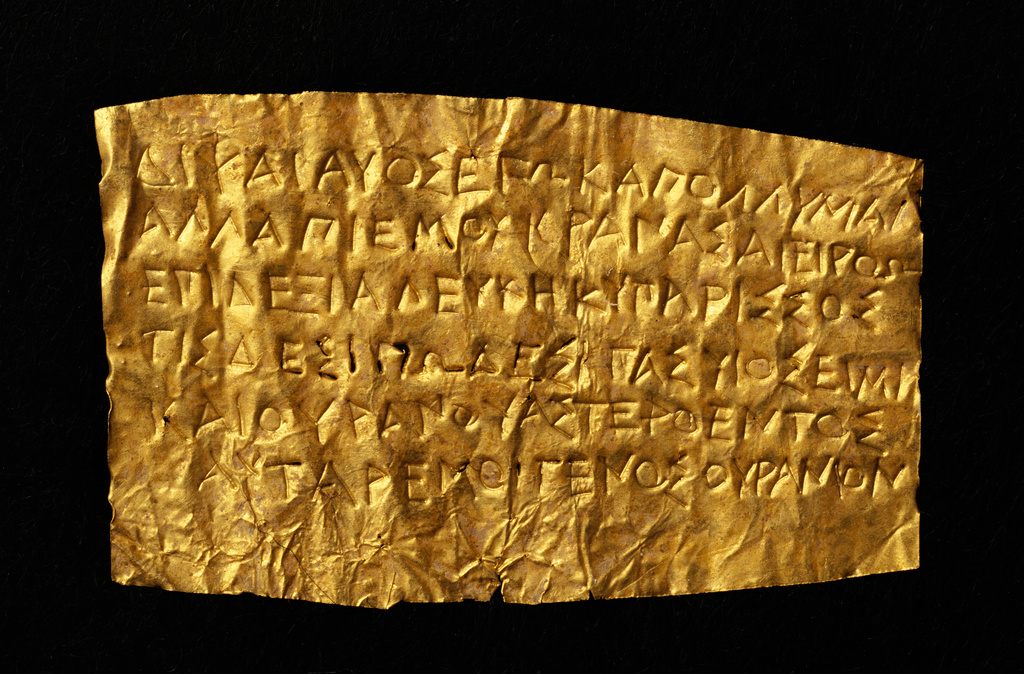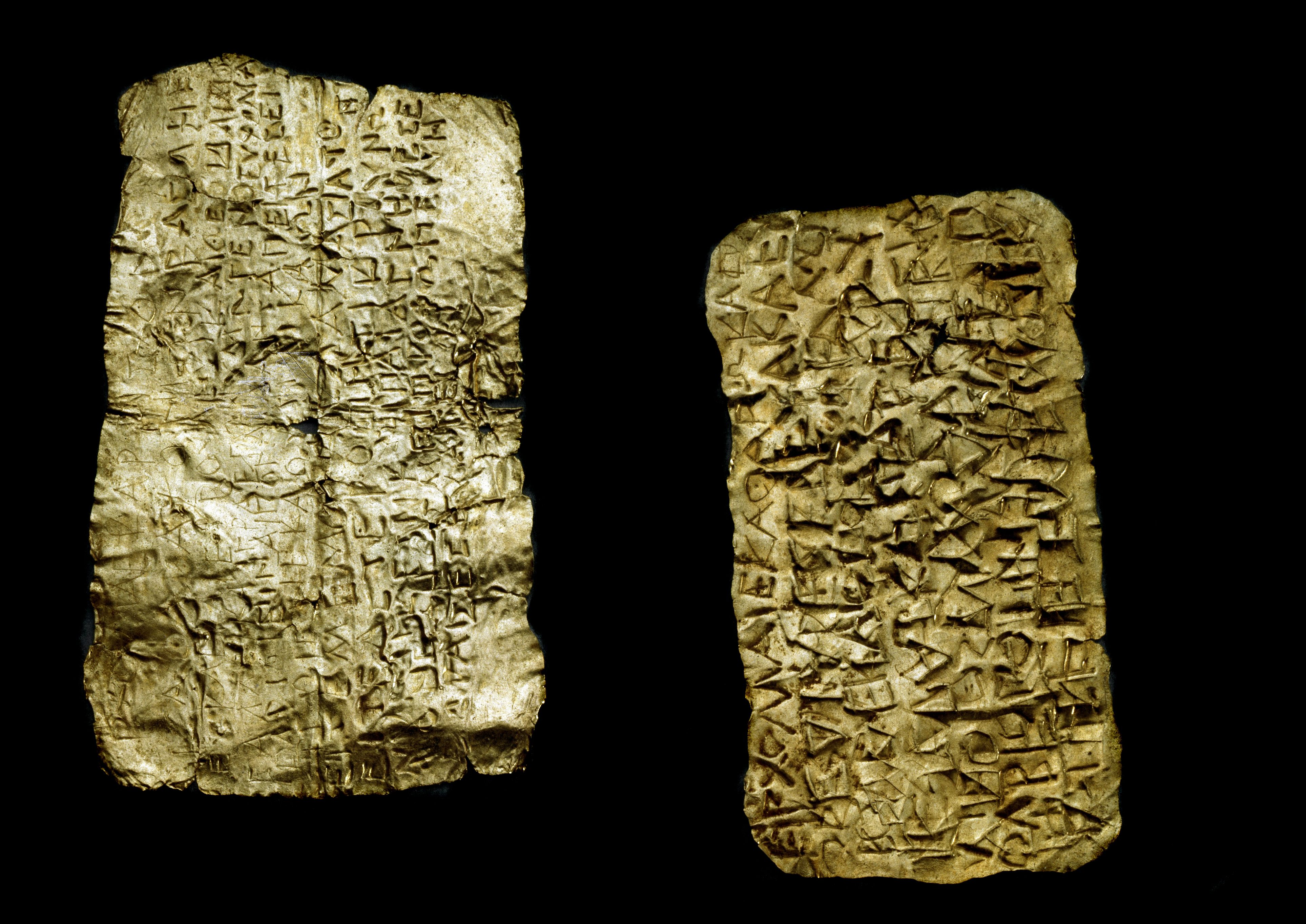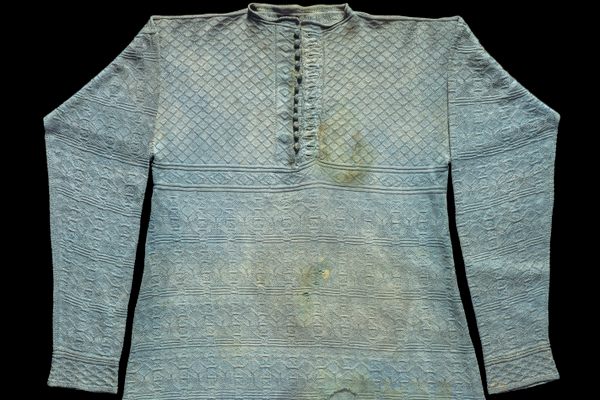The Ancient Greeks Created Golden Passports to Paradise
Engraved pieces of foil aimed to ensure the spirits of worthy dead people made it safely to Elysium.

What’s the best way to ensure a spot in paradise? To some ancient Greeks, the answer was burying themselves with golden tablets engraved with ritual texts. These served as passports by confirming the initiates’ identity and purity and allowing them to move easily between the mortal and divine realms, protecting the dead from any evils that might haunt them along the way.
For the ancient Greeks, paradise was just one part of the Underworld, the domain ruled by Hades and his child bride, Persephone. In theory, only humans and heroes of semi-divine lineage, like Heracles, Orpheus, and Odysseus, get to enter the Underworld by descending through caves and subterranean locations, then scooting past Cerberus, Hades’s three-headed guard dog. Much like Dante’s Inferno, the realm of Hades was divided into many different areas; where the deceased ended up depended on their deeds during life. Elysium, or the Elysian Fields, was paradisiacal, the final resting place of the best of the Greeks. The worst resided in Tartarus, a cosmic pit where the gods’ enemies, the Titans, were confined; later, the gods consigned humans who offended them to Tartarus.


The golden tablets designed to ease the path to Elysium were called lamellae in Latin. They are small pieces of foil inscribed with guides to paradise, written from the perspective of the deceased. Dating from the fourth and third centuries BC, they have most often been discovered in gravesites. About 30 to 40 of them have been found across the Greek-speaking Mediterranean, from the island of Crete to the mainland region of Thessaly in northern Greece and “Magna Graecia,” a region of coastal Southern Italy colonized by the Ancient Greeks.
Early archaeologists associated these “passports to the afterlife” with Orpheus, a mythical hero closely associated with the Underworld, but these tablets don’t actually reference Orpheus. Rather, the texts provided instructions for how to properly behave in paradise and acted as amulets protecting the people with whom they were buried.
The plethora of ancient mystery cults promised devotees a special place in the afterlife through initiation and participation in ritual; the particular cult that created these passports was never named. Unlike others, this cult wasn’t centered in any single location. Its beliefs were spread by itinerant preachers who traveled the Greek-speaking world; these bear some similarities to the practices of “Orpheus initiators” referenced by Plato, so-called “priest-poets” who went from town to town, selling purification rites and a place in paradise to willing initiates. Plato associated these preachers with Orpheus, who went to the Underworld and came back alive, perhaps fueling modern associations with “Orphism,” a movement that may not have even existed in the ancient world.

In the late 19th century, four remarkable lamellae were found in a graveyard in Thurii in southern Italy. The inscriptions on these tablets describe just how holy—nearly divine—the deceased was, and allows them access to the best parts of the Underworld. On one tablet, the narrator informs gods associated with the Underworld—Persephone, Hades, and Dionysus, under other epithets—that they, too, “come from the pure,” emphasizing the purity and holiness of the person who’d died and that of their family. The tablet adds, “I too claim to be of your blessed race, but Fate and other Immortal Gods conquered me, the star-smiting thunder.”
Aside from a few names, we don’t know much about the initiates. Archaeologists who came across lamellae in the late 19th and early 20th centuries kept poor records and often failed to note the tablets’ provenance and context in which they were discovered, meaning we can’t determine the social status, gender, or much else of the person buried alongside. Scholar Shellie Smith posits, “The great variation in length of the lamellae indicate that initiates from different classes were followers, as scribes charged by the letter.” Whatever their status in life, the initiates underwent a transformative ritual that turned them to divine-like beings. Several Thurii lamellae compare the deceased to sacrificial animals “falling” into milk; perhaps an initiate was immersed in milk, a sacred, cleansing agent, and then emerged ritually sanctified.
Surviving text on a lamella from Petelia in southern Italy provides a road map to paradise. It instructs the deceased to bypass a spring and a white cypress, then proceed to the Lake of Memory and utter the following message: “I am the child of Ge and starry Ouranos; this you yourselves also know. I am dry with thirst and am perishing. Come, give me at once cold water flowing forth from the Lake of Memory.” The earliest-known tablet, found at Hipponion, adds, “And then you will walk on the holy path of the many, on which also other renowned mystai and bakkhoi walk.” This means that, because of their initiation, the deceased on the lamellae will occupy a sacred, elite space even in the Underworld, occupied by others inducted into similar cults: the mystae, followers of the Eleusinian Mysteries, and bakkhoi, initiates into Dionysus’s rites.




















Follow us on Twitter to get the latest on the world's hidden wonders.
Like us on Facebook to get the latest on the world's hidden wonders.
Follow us on Twitter Like us on Facebook